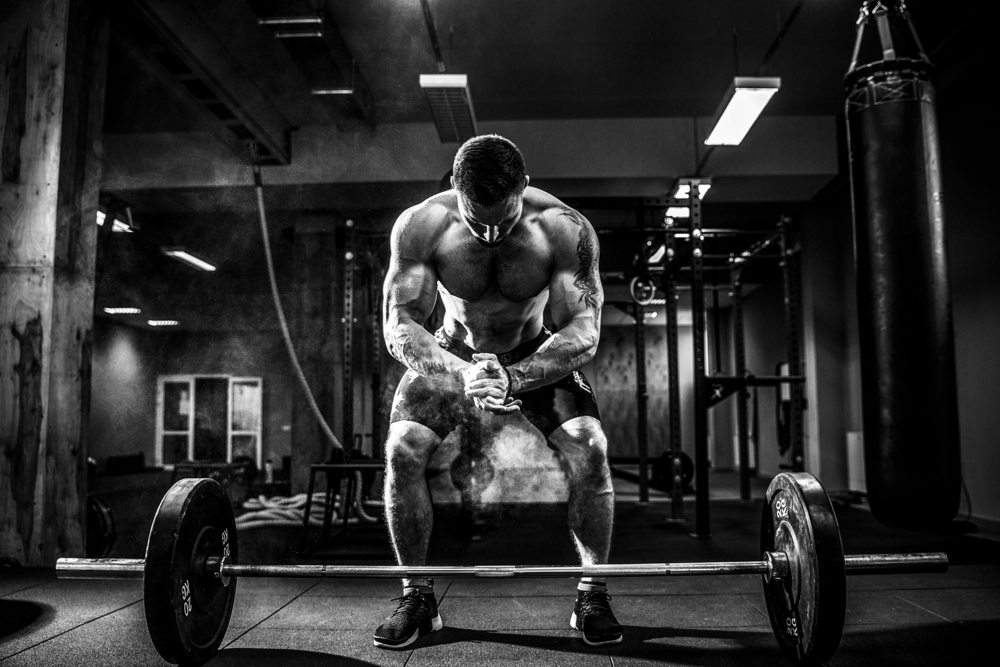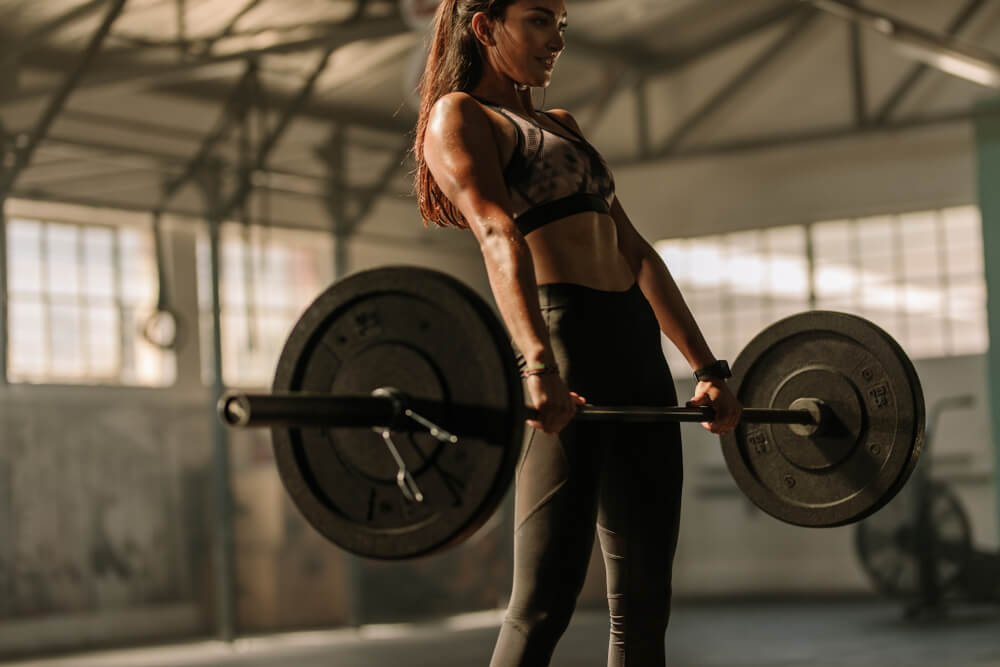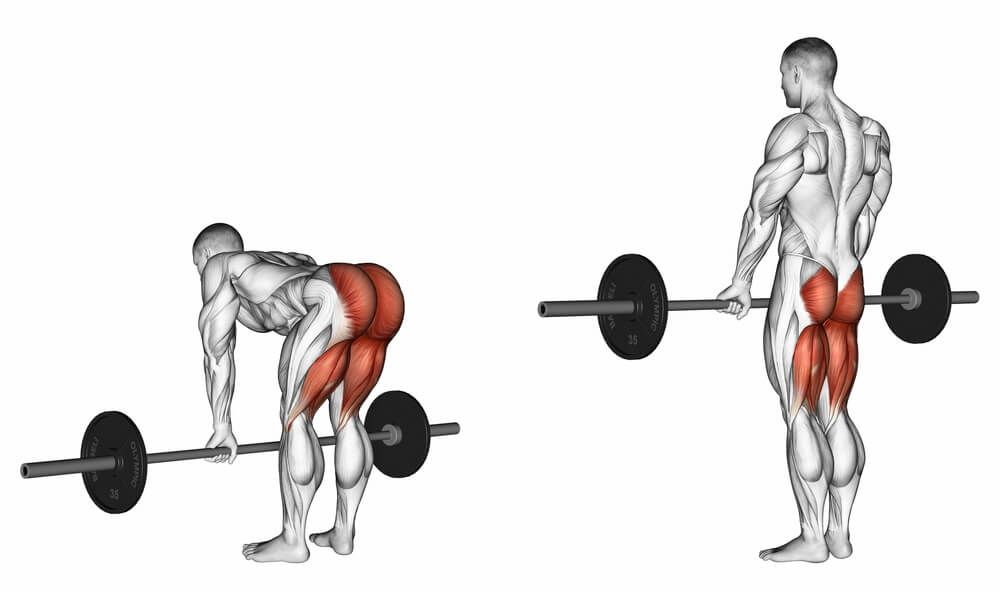
Deficit deadlifts are a controversial exercise – some people swear by them as a way to improve their traditional deadlifts, but others are adamant that they are too dangerous. When performed correctly, deficit deadlifts are perfectly safe, and they can be a helpful addition to your lifting routine. Here’s what you need to know about deficit deadlifts and how to do them effectively.
What is a deficit deadlift?
A deficit deadlift is similar to a traditional deadlift, but it is done standing on a platform of about three inches. Many people use weight plates as their platform. This extra height forces you to use more of your body to lift the weight, which is great for building all-over strength. These are also great for improving your traditional deadlifts, particularly if you normally struggle to get the lift going off the floor.
How to Do A Deficit Deadlift
Start by setting up your platform, and have the bar centered over your feet on the floor.
Focus on keeping your feet in alignment with your hips. Bend at the hip to grip the bar and prepare for the lift. It’s crucial that you bend at the hip and keep your back straight, as a curved spine won’t provide enough leverage and could put you at risk for injury. Once you have your grip in place, bend your knees and lower your hips, pulling the weight up to your shins.
Then, put your weight into the heels for stability, maintain your posture, and continue to pull the bar up. You can look forward and arch your back slightly during this movement. Once you’ve gotten the bar above your knees, pull the weight back and straighten up, pulling your shoulder blades together and hips forward. You’ll need to do this in one motion to ensure you have enough leverage to get the bar up. Your lower back will naturally start to round as you do this to allow you to access your full strength.
When choosing the bar to use for your deficit deadlift, use what you would typically use when doing a traditional deadlift. You should also use the same grip technique for this as you would with other deadlifts. Keeping your technique the same is the best way to access your strength. Most people use an over grip with this type of lift, but there are multiple ways to do it.
Benefits of Deficit Deadlift
There are many benefits to doing a deficit deadlift. They are particularly helpful if you have very long arms, because you may actually get better leverage by lifting from a deficit than by lifting straight off the floor.
They are excellent for both your overall strength and your lifting technique.
– Deficit deadlifts help you improve your control and strength through the entire range of motion while lifting. Many people struggle to get the bar off the floor in traditional deadlifts. If you find that this is a challenge you face, adding deficit deadlifts to your routine is a great way to target this weak spot.
– Deficits are great for building leg strength. They force you to drive into your feet for stability and use more flexion in your hips and bend in the knees. This in turn forces you to strengthen your quadriceps for maximum power.
– Deficits will also help you increase strength in your lower back and hips. There aren’t many other lifts that require you to use your back and legs this intensely, so they are great if you want to build strength and power in this part of the body.
– They also increase your weight lifting stamina. Since deficit deadlifts have a longer pull than a traditional deadlift, they’re a great way to increase the amount of time your muscles are capable of staying active for. This is incredibly helpful not only for weight lifting, but also for other athletic activities that require you to engage your muscles for long periods of time.
– They are also great for practicing your coordination and alignment. In order to do these lifts successfully, you will need to have each part of your body in the correct place, and you’ll need to be able to coordinate the movements of your hips, knees, and arms to gather enough leverage. This will improve your alignment, particularly in your lower back and hips, when doing other types of lifts.
– Deficit deadlifts can also be very helpful for those who play certain types of sports. Football players, wrestlers, fighters, and many other athletes need to maintain upper body strength even when their hips and lower back are in a position that’s not ideal for leverage. Deficit deadlifts help to build strength in many different positions, so you’ll still be able to use your muscles to their full ability even when you aren’t in a great position.
Doing Deficit Deadlifts Safely
It’s important to be very careful when doing deficit deadlifts, because they do present an increased risk of injury to your lower back.
The key is to find the right height and angle of the platform and maintain the right level of hip flexion. The higher the platform, the more difficult it is going to be to deadlift.
While some people can work up to a higher platform to build more strength, most people are limited as to how far they can go. To figure out your maximum platform size, subtract your height from your wingspan and divide by two. This is the maximum amount of deficit that you should try to pull from. However, you should start at a smaller deficit and work up to pulling from a higher platform, so that you can build up strength. If your wingspan isn’t much longer than your height, or is shorter than your height, you likely won’t be able to pull from a deficit safely.
Before trying a deficit deadlift, you should work on reaching the bar with your spine in a neutral, flat position and getting a stable grip. This technique is essential to prevent back injuries. If your back is arched when you start the deadlift, or worse, if it’s curved upward, you risk putting an undue amount of stress on your spine and getting injured. When starting with a deficit deadlift, begin with a small deficit, and only increase your platform height if you’ve mastered the lift with the correct alignment. This will help you slowly improve your mobility and technique before trying a harder deadlift.
How much should I deficit deadlift?
You may wonder how much you should be lifting when doing a deficit deadlift.
You shouldn’t go for the full weight you would use with a traditional deadlift, because deficit deadlifts require more strength and technique. A good rule of thumb is to start at 90 percent of your maximum weight for a 1-inch deficit, then subtract 10 percent for each additional inch. For example, if you do a two inch deadlift, it would be 80 percent of your maximum floor weight. Start conservatively with deficit deadlifts, as they can be quite strenuous at first. However, once you have mastered the technique, you can go above 90 percent of your maximum if you feel comfortable with it.
You can also use deficit deadlifts specifically for improving your strength in the traditional deadlift, in which case, there’s no need to lift nearly as much. Two-thirds of your maximum weight will still make a difference and won’t put so much strain on your body. When you go back to doing the traditional deadlift, you’ll find that you have more power and can potentially even increase your maximum weight.
How often should I deficit deadlift?
If you want to use deficit deadlifts in your workouts, put them into a rotation with other types of lifts so as not to overwork one part of the body. Rotating between traditional deadlifts, a deadlift from a small deficit, and a deadlift from your max deficit is a good way to make sure you build strength in your full range of motion.
Of course, you should make sure to give yourself rest days from deadlifting and focus on other parts of your body to prevent soreness and muscle strain. You may want to experiment with a deadlifting cycle until you find the combination of heights and weights that work best for you. A three to four week rotation is typically an effective option for most lifters.
Who should and shouldn’t do the deficit deadlift?
If you have shorter arms and already struggle to maintain your alignment in a traditional deadlift, you should probably stay away from deficit deadlifts.
With your body structure, this could put you in danger of getting injured. It will also be very difficult for you to get a good grip on the bar for a lift. Alternatively, if you have very long arms, you should definitely add the deficit deadlift to your routine. You’ll really benefit from working through the lower part of the lift and building strength up in your back and legs. Your long arms will also give you more leverage and control when lifting.
Beginner lifters can do the deficit deadlift, as long as they are maintaining the right alignment. If you are just getting started with lifting, you may want to work with a trainer or an experienced friend, just to get a little bit of extra guidance. Deficit deadlifts can actually be quite helpful for beginners, because they help you build strength in the lowest part of the lift, and they also help you practice your coordination and develop better power as you pull the bar up. They’re just as helpful for advanced lifters or any athlete who wants to cross-train with lifting. The extra strength you’ll build in your legs and lower back will be very valuable in a variety of other athletic pursuits.
If you struggle with mobility in your back and hips, be sure to approach the deficit deadlift with caution. That’s not to say that you won’t be able to do it, but you may need to work on improving the range of motion in your hips and keeping your back straight before you can safely try the deficit deadlift. Don’t get frustrated if you can’t do this challenging exercise right away – it’s one that many people feel the need to work up to. Baby steps are the best approach with this exercise, so you can work up to success without getting injured.
Conclusion
If you’re trying to increase your strength, range of motion, and time under tension, adding deficit deadlifts to your routine is worth considering. For those who have the right body proportions and alignment, this exercise can be incredibly beneficial, particularly when alternated with traditional deadlifts. Give this one a try next time you’re at the gym and see your full body strength and power increase.
-Terry Asher
Terry Asher
Latest posts by Terry Asher (see all)
- Better Family – Product Review Liquid Daily 2 oz - Dec 16, 2024
- Post-Workout Recovery: The Key to Optimal Performance - Nov 25, 2024
- Pre-Workout Supplements – Everything You Need To Know - Nov 18, 2024














[…] 2019-09-16 21:31:08 https://gymjunkies.com/wp-content/uploads/2019/09/shutterstock_718117552-3.jpg Source link […]
[…] post How to Master Deficit Deadlifts appeared first on Gym […]
[…] Read The Entire Article By Terry Asher Here. […]
I’m looking for some tools to begin. How can I purchase them?
This really helps me a lot. I hope to see more updates from you about this topic.
[…] quite a lot of leg workouts together with squats, deadlifts, lunges, and accent work to focus on all areas of the legs […]